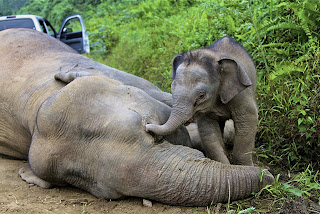The Borneo pygmy elephant may
not be native to Borneo after all. Instead, the population could be the last
survivors of the Javan elephant race - accidentally saved from extinction by
the Sultan of Sulu centuries ago, a new publication suggests. The origins of
the pygmy elephants, found in a range extending from the north-east of the
island into the Heart of Borneo, have long been shrouded in mystery. Their
looks and behavior differ from other Asian elephants and scientists have questioned
why they never dispersed to other parts of the island.
General Information
Population: There is approximately 1,500 pygmy elephants.
Height: Pygmy elephants usually grow to 8.2 - 9.8 feet (average Asian elephants grow to around 13 feet).
Habitats: Elephants tend to live in grasslands and forests.
Life-span: Elephants normally live for up to 60 years in the wild and more than 80 years in captivity.
Gestation period: Pygmy elephants gestation period is between 19-22 months (almost 2 years!).
Family life: Pygmy elephants are usually led by a female (matriarch) in small groups of about eight, families consist of mothers, daughters, sisters and young males (occasionally an adult male). The adult males usually travel individually. The males sometimes gather in temporary herds.
Diet: Elephants are forest herbivores. One elephant can eat up to 330 lbs. of vegetation per day. They eat mostly palms grasses and wild bananas. They obtain minerals from salt licks.
Color: All elephants usually range from light grey to dark brown.
The Borneo
pygmy elephant may not be native to Borneo after all. Instead, the population
could be the last survivors of the Javan elephant race – accidentally saved
from extinction by the Sultan of Sulu centuries ago, a new publication
suggests.
The origins of the
pygmy elephants, found in a range extending from the north-east of the island
into the Heart of Borneo, have long been shrouded in mystery. Their looks and
behaviour differ from other Asian elephants and scientists have questioned why
they never dispersed to other parts of the island.
But a new paper
published supports a long-held local belief that the elephants were brought to
Borneo centuries ago by the Sultan of Sulu, now in the Philippines, and later
abandoned in the jungle.
The Sulu elephants, in turn, are thought to have
originated in Java.
Javan elephants
became extinct some time in the period after Europeans arrived in South-East
Asia. Elephants on Sulu, never considered native to the island, were hunted out
in the 1800s.
“Elephants were shipped
from place to place across Asia many hundreds of years ago, usually as gifts
between rulers,” said Mr Shim Phyau Soon, a retired Malaysian forester whose
ideas on the origins of the elephants partly inspired the current research.
“It’s exciting to consider that the forest-dwelling Borneo elephants may be the
last vestiges of a subspecies that went extinct on its native Java Island, in
Indonesia, centuries ago.”
If the Borneo pygmy
elephants are in fact elephants from Java, an island more than 1,200 km (800
miles) south of their current range, it could be the first known elephant
translocation in history that has survived to modern times, providing
scientists with critical data from a centuries-long experiment.
Scientists solved
part of the mystery in 2003, when DNA testing by Columbia University and WWF
ruled out the possibility that the Borneo elephants were from Sumatra or
mainland Asia, where the other Asian subspecies are found, leaving either
Borneo or Java as the most probable source.
The new paper,
“Origins of the Elephants Elephas Maximus L. of Borneo,” published in this
month’s Sarawak Museum Journal shows that there is no archaeological evidence
of a long-term elephant presence on Borneo.
“Just one fertile
female and one fertile male elephant, if left undisturbed in enough good
habitat, could in theory end up as a population of 2,000 elephants within less
than 300 years,” said Junaidi Payne of WWF, one of the paper’s co-authors. “And that may be what
happened in practice here.”
There are perhaps
just 1,000 of the elephants in the wild, mostly in the Malaysian state of
Sabah.
WWF satellite tracking has shown they prefer the same lowland habitat
that is being increasingly cleared for timber rubber and palm oil plantations.
Their possible origins in Java make them even more a conservation priority.
“If they came from
Java, this fascinating story demonstrates the value of efforts to save even
small populations of certain species, often thought to be doomed,” said Dr
Christy Williams, coordinator of WWF’s Asian elephant and rhino programme. “It
gives us the courage to propose such undertakings with the small remaining
populations of critically endangered Sumatran rhinos and Javan rhinos, by
translocating a few to better habitats to increase their numbers. It has worked
for Africa’s southern white rhinos and Indian rhinos, and now we have seen it
may have worked for the Javan elephant, too.”
Conservation: Conflict with Humans
The primary threat to these elephants is the loss of continuous forests. Mammals of their size require large areas to find sufficient food. The large blocks of forests they require are fragmented by encroachment and conversion of natural forests to commercial plantations. Logging, expanding agriculture, and palm oil plantations are reducing contact between sub populations, as well as shrinking the forest area available for each sub-population.
Shrinking forests bring the elephants into more frequent contact with people, increasing human -elephant conflict in the region. New oil palm plantations in the area mean more human settlements, with some people setting illegal snares to catch small game. In the Lower Kinabatangan Wildlife Sanctuary, it is estimated that 20% of resident elephants have sustained injuries from these snares.
The catastrophic decline of more species of the big area of South East Asia are in the deforestation, palm oil plantations and poachers.









No hay comentarios:
Publicar un comentario